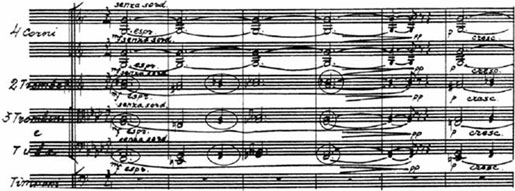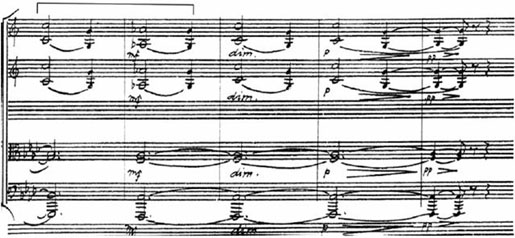Alfred Schnittke—Shostakovich's Heir (cont'd)
III. Schnittke’s Piano Quintet vs.
Shostakovich’s 15th Symphony/8th String Quartet
When listening to Schnittke’s Quintet, a great work by Shostakovich might well come to mind – and that is his Eighth String Quartet (hereinafter referred to as the Quartet). Firstly, because of a similar structure: the five-movement cyclic piece is performed attacca (no pause); secondly, because of the requiem-like music dedicated to the memory of the dead (the Quartet is dedicated to the memory of victims of fascism and war).23 There is also a deeper connection between the two works – and that is the use of a monothematic type of musical material. In both works, the themes of all movements grow from a single motive - the D-S-C-H monogram in the Quartet, and the introductory theme based on a sequence of seconds in the Quintet.
This connection between the two chamber works ‘lies on the surface’ and is easily observed. However, there are deeper layers in the music of the Quintet that are prone to incite the listener to think of Shostakovich’s music. To do so, one should carefully listen to the Quintet again. Indeed, another work of Shostakovich might come to mind – and that is his last, Fifteenth Symphony (hereinafter referred to as the Fifteenth) completed in 1971, only one year before the Schnittke’s music of the Quintet started to take shape (1972). A. Ivashkin noted in this regard, ‘Since the 1970s, Schnittke’s music sounded more like the late works of Shostakovich than his own serial compositions of the 1960s.’24 I am attempting here to create a list of stylistic features that manifest themselves in the two compositions:
-
Treatment of quotations or anagrams – in both works, quotations are highly assimilated and perceived naturally as an inalienable part of the work. For instance, in the Fifteenth: a) the overture theme from the Rossini’s William Tell in the first movement; b) the ‘fate’ motive from the Wagner’s Ring in the finale; in the Quintet – the BACH theme in the second movement.
-
Similarity in thematic material: in the Fifteenth - the chorale theme of the second movement (brass playing)25 (see Example 10); in the Quintet - the introductory leitmotive: both themes - the combination of seconds with a central pivot tone.
-
Treatment of thematic material: in both works – self-quotations (themes from previous movements are quoted in the final movement).
-
Pitch material: In the finale of the Fifteenth – the use of enharmonic tones in the strings (section 138, Allegretto, pizzicato) – an immediate predecessor of the quartertones in the Quintet (creating the same ‘ghostly’ effect).26 See Example 11.
-
Instrumentation:
-
treatment of instrumental solos in both works: violins and cellos – the expression of human in its opposition to evil (see the previous discussion);
-
the intensive use of percussion: the Fifteenth’s percussion group utilises fifteen instruments (!) with some of them playing solos (celesta, vibraphone); in the Quintet - imitation of percussion timbres in the piano part and use of actual percussion in the In Memoriam; the role of percussion in the codas – reflection of the ‘virtual’ reality (phantoms, ghosts and other ‘inhuman’ personages).
-
-
Texture: ‘Rarefied’ texture, with opposition of dark and light. [David Hurwitz provided the following description of the Fifteenth’s texture: ‘The greatly enlarged percussion section confirms Shostakovich’s preference for light, airy and luminous textures in this late work. Not that darkness is absent; but its presence generally exists in stark opposition to the brighter moments. The music similarly tends towards contrasts of top and bottom, consecutively or simultaneously, but with little filler in the middle’ (my italics – S.G.)]27 A great master of polyphony, Shostakovich used intensely contrasting polyphony (e.g., thematically contrasting); however, he never ‘crossed the border’ between traditional (classical) and modern textural organisation in the way of Schnittke’s musical language – polyphony of layers (stylistically different and fully independent layers of music) and micropolyphony.
Forms:
-
short but intensive developments of main themes with strong dramatic climaxes;
the use of passacaglias (and ostinatos, in general) as polyphonic forms: in both works, in the final movements. In the Fifteenth, passacaglia begins in bar 125 of the fourth movement (episode C - central in the symmetrical form ABCBA). Amazingly, both themes are 14 bars long! (Shostakovich’s theme in low bases – an obvious reference to the ‘invasion’ theme of the Seventh Symphony – one of the ‘hidden’ self-quotations in this symphony.)
Openness of forms – long codas of the finales (in the Fifteenth); the entire movement is a coda of the cyclic piece (in the Quintet). As David Hurwitz noted about the Fifteenth, ‘the ending of this work gazes unflinchingly out into infinity.’28 As A. Ivashkin noted regarding the Quintet, it is ‘disappearing toward the end and dying out entirely: the pianist stops pressing the keys but continues to play, silently.’29 The following statement expresses the essence of Schnittke’s and Shostakovich’s finales: ‘…and common to both is extreme pessimism: many works of late Shostakovich and Schnittke are ‘dying’, dissolving in the world, fading into the distance of time.’30
-
-
Finally, the transitional themes connecting conceptually the Quartet and the Quintet through the Fifteenth: there is a clear self-quotation in the coda of the second movement of the Fifteenth – from the final movement of the Quartet: the mourning motive consisting of the descending fourth and second – C–GG, Ab–G (in the Fifteenth – with one G) – conveys the funeral atmosphere from the Quartet – through the Fifteenth – to the Quintet. See Example 12.
I would like to finish this article with the words of A. Ivashkin, ‘The fundamental significance and symbolic plane of Schnittke’s music is closest of all to the work of Dmitry Shostakovich. It was Alfred Schnittke who filled the gap in Russian music left by Shostakovich’s death in 1975.’31
Example 10. Shostakovich, Symphony No. 15. Second Movement.
The Chorale Theme in the Brasses (circled are the pivot tones)

Example 11. Shostakovich, Symphony No. 15. Final Movement.
Circled are enharmonic tones in the strings.

Example 12. Shostakovich, Symphony No. 15. Second Movement (coda).
Bracketed is the modified auto-quotation from the Finale of the Eighth String Quartet.

« Previous: Schnittke’s Piano Quintet—Traditional vs. New Language (Stylistic Analysis)
Footnotes
23 This dedication was a result of coercion from the Soviet government officials. Initially, Shostakovich wanted to dedicate the Eighth Quartet to his own memory.
24 A. Ivashkin. Schnittke, p. 123.
25 The brass theme (chorale) from the second movement of the Fifteenth immediately comes to mind when listening to the passacaglia theme played on trombones in Schnittke’s Cello Concerto No. 2 (the final movement).
26 In the finale of his final symphony, Shostakovich was just one step away from the ‘modern’ use of strings that Schnittke fully realised – the use of quartertones.
27 D. Hurwitz. Shostakovich, Symphonies and Concertos. An Owner’s Manual. Unlocking the Masters Series, No. 9. Amadeus Press.
28 D. Hurwitz, p. 211.
29 A. Ivashkin. Schnittke, p. 133.
30 A. Ivashkin. Shostakovich and Schnittke: the erosion of symphonic syntax, p. 270.
31 A. Ivashkin. Schnittke, p. 169.
